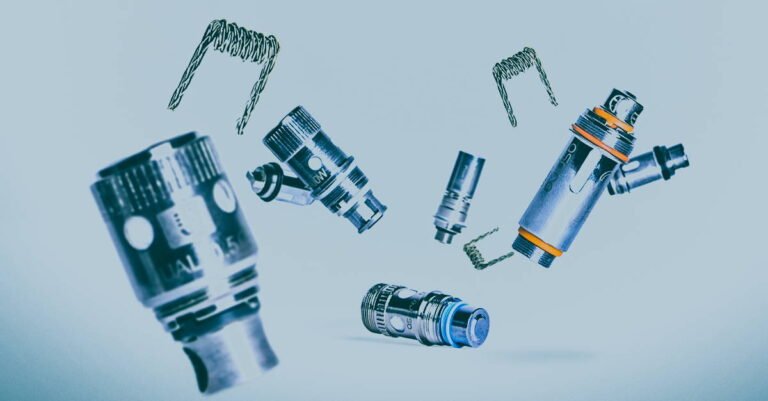Vaping has become a popular alternative to smoking, and understanding the components of your vaping device is essential for a satisfying experience. One of the most crucial parts of a vape device is the coil. In this beginner’s guide, we’ll delve into what vape coils are, their types, how they work, and tips for maintaining them.
What is a Vape Coil?
A vape coil is a piece of resistance wire wrapped in a spiral shape, housed within your vaping device. It is responsible for heating the e-liquid and converting it into vapor. The coil is typically surrounded by a wicking material, usually cotton, that absorbs the e-liquid. When the device is activated, the battery sends a current through the coil, heating it up and vaporizing the e-liquid.
Types of Vape Coils
There are several types of vape coils available, each offering a different vaping experience. Here are the most common ones:
Kanthal Coils:
Material: Made from iron, chromium, and aluminum.
Usage: Ideal for wattage mode.
Pros: Durable, widely available, and easy to work with.
Cons: Slow ramp-up time.
Stainless Steel Coils:
Material: Stainless steel.
Usage: Can be used in both wattage and temperature control modes.
Pros: Versatile, quick ramp-up time, and clean flavor.
Cons: Can be more expensive than Kanthal.
Nichrome Coils:
Material: Nickel and chromium.
Usage: Primarily for wattage mode.
Pros: Quick ramp-up time and consistent performance.
Cons: Some users may have nickel allergies.
Nickel (Ni200) Coils:
Material: Pure nickel.
Usage: Exclusively for temperature control mode.
Pros: Excellent for temperature control.
Cons: Not suitable for wattage mode and potential nickel allergies.
Titanium Coils:
Material: Titanium.
Usage: Temperature control mode.
Pros: Precise temperature control.
Cons: Can be hazardous if overheated.
How Vape Coils Work
The functionality of vape coils is rooted in basic electrical principles. When the device is activated, the battery sends an electrical current through the coil, causing it to heat up. The wicking material surrounding the coil absorbs the e-liquid from the tank. As the coil heats up, it vaporizes the e-liquid on the wick, creating vapor that you inhale.
The resistance of the coil, measured in ohms (Ω), determines the amount of heat produced. Lower resistance coils (sub-ohm coils, less than 1Ω) heat up faster and produce more vapor, suitable for direct-to-lung (DTL) vaping. Higher resistance coils (above 1Ω) produce less vapor and are better for mouth-to-lung (MTL) vaping, which mimics the sensation of smoking a traditional cigarette.
Choosing the Right Coil
Selecting the right coil depends on your vaping preferences:
Vaping Style:
MTL Vaping: Higher resistance coils (above 1Ω) are ideal.
DTL Vaping: Lower resistance coils (below 1Ω) provide more vapor and flavor.
Device Compatibility:
Ensure the coil you choose is compatible with your vaping device. Manufacturers often produce coils specifically designed for their products.
E-Liquid:
Different coils work better with certain e-liquids. For instance, sub-ohm coils perform well with high VG (vegetable glycerin) e-liquids, while higher resistance coils are better with high PG (propylene glycol) e-liquids.
Maintaining Your Vape Coils
Proper maintenance of your vape coils in Dubai is crucial for a consistent and enjoyable vaping experience. Here are some tips:
Priming the Coil:
Before using a new coil, prime it by saturating the wick with e-liquid. Allow it to sit for a few minutes to prevent dry hits and extend coil life.
Regular Cleaning:
Clean your coils regularly to remove residue and gunk. Rinse them in warm water and let them dry thoroughly before reuse.
Avoid Chain Vaping:
Allow time between puffs to prevent the coil from overheating and burning the wick.
Use the Right Wattage:
Check the recommended wattage range for your coil and avoid exceeding it. Too much power can quickly burn out the coil.
Monitor E-Liquid Levels:
Keep your tank filled to prevent dry hits, which can damage the coil.
When to Replace Your Coil
Even with the best care, vape coils have a limited lifespan. Signs that it’s time to replace your coil include:
Burnt Taste: A burnt or unpleasant taste indicates the wick is burnt out.
Decreased Vapor Production: If your device produces less vapor, the coil may be worn out.
Leaking: Frequent leaks can be a sign of a failing coil.
Conclusion
Understanding vape coils is essential for anyone new to vaping. The type of coil you choose and how well you maintain it can significantly impact your vaping experience. By following this guide, you’ll be better equipped to select the right coil, care for it properly, and enjoy a satisfying vape every time.

